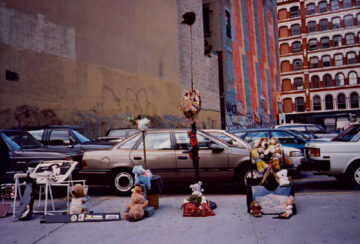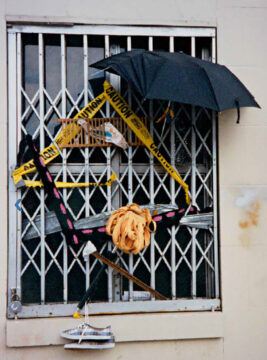by Andrea Scrima

I recognized the corner immediately: it was right next to Cooper Union, on Lafayette Street in downtown Manhattan. There used to be a large parking lot on the other side of the street, where passers-by occasionally happened upon a colorful bricolage cobbled together from stuffed animals and clothes, discarded household items, deformed umbrellas, and battered car parts. These strange and playful conglomerations looked as though the bric-a-brac and refuse had been plucked together by some invisible furious force to house a spirit or daemon. They were, of course, carefully composed works by the late African-American artist Curtis Cuffie, one of the many ephemeral assemblages he created in the streets of downtown New York in the 1980s and 1990s.

Cuffie installed his improvised ensembles of found objects on fences, window grilles, sidewalks, and traffic signs in Cooper Square, the Bowery, and elsewhere; they were always temporary, and only a few of his works have survived. Cuffie periodically lived on the streets around Cooper Square and his homelessness must have made his emotional tie to the treasures he found and wheeled around in shopping carts all the more urgent. Most of the works he created from this repertoire of materials were abstract, shrines that seemed to grow out of the flotsam and jetsam of a city in constant transformation; seen from a passing car, they flashed in the sideview mirror like otherworldly apparitions. But there were also figurative sculptures: ragged garments strung on wire and string and adorned with hats or wigs became animated spirits on a secret mission. Today, the few remaining works by Cuffie that were not taken down and destroyed by the police or street cleaners are shown and sold in the pristine white spaces of uptown Manhattan galleries, stripped of their context and also, perhaps, a good deal of their meaning. Read more »
